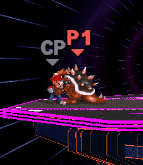Multi-hit throw: Difference between revisions
Serpent King (talk | contribs) m (Not enough to get rid of the stub, but at least it's something) |
Serpent King (talk | contribs) mNo edit summary |
||
| Line 1: | Line 1: | ||
{{ArticleIcons|allgames=y}} | {{ArticleIcons|allgames=y}} | ||
{{stub|Perhaps a list of multi-hit throws for each game?}} | |||
[[File:MultiHitThrow.gif|thumb|right|[[Bowser]] using his multi-hitting up-throw on [[Mario]].]] | [[File:MultiHitThrow.gif|thumb|right|[[Bowser]] using his multi-hitting up-throw on [[Mario]].]] | ||
A '''multi-hit throw''' is a [[throw]] that does damage in multiple parts. Typically, this is accomplished with a [[hitbox]] that strikes the grabbed opponent before they are released. An obvious example is [[Bowser]]'s up throw, where the opponent is slashed multiple times with Bowser's shell before they are actually thrown. Multi-hit throws typically result in a throw dealing less [[knockback]] for the same amount of damage (due to how the knockback formula operates), but have the advantage of still slightly damaging the opponent even if the user is interrupted by something else. Several multi-hit throws cannot be distinguished as being multi-hit without reducing the game speed, as their hitbox strikes a [[frame]] or two before the throw occurs, such as {{SSBM|Captain Falcon}}'s forward, back, and up throws in ''Melee''. | A '''multi-hit throw''' is a [[throw]] that does damage in multiple parts. Typically, this is accomplished with a [[hitbox]] that strikes the grabbed opponent before they are released. An obvious example is [[Bowser]]'s up throw, where the opponent is slashed multiple times with Bowser's shell before they are actually thrown. Multi-hit throws typically result in a throw dealing less [[knockback]] for the same amount of damage (due to how the knockback formula operates), but have the advantage of still slightly damaging the opponent even if the user is interrupted by something else. Several multi-hit throws cannot be distinguished as being multi-hit without reducing the game speed, as their hitbox strikes a [[frame]] or two before the throw occurs, such as {{SSBM|Captain Falcon}}'s forward, back, and up throws in ''Melee''. | ||
| Line 8: | Line 9: | ||
Multi-hit throws whose animation speed is based on the opponent's [[weight]] run the risk of rounding causing one-frame hitboxes to appear and disappear without the game checking to see if anyone has been hit. As a result, some throws don't deal as much damage as they should on opponents of a specific weight. Examples include {{SSBM|Bowser}}'s down throw in [[NTSC]] ''Melee'' and {{SSBB|Link}}'s down throw in ''Brawl'', the former of which misses its first hit when throwing {{SSBM|Jigglypuff}} or {{SSBM|Mr. Game & Watch}}, and the latter of which misses its first hit when throwing {{SSBB|Jigglypuff}}. | Multi-hit throws whose animation speed is based on the opponent's [[weight]] run the risk of rounding causing one-frame hitboxes to appear and disappear without the game checking to see if anyone has been hit. As a result, some throws don't deal as much damage as they should on opponents of a specific weight. Examples include {{SSBM|Bowser}}'s down throw in [[NTSC]] ''Melee'' and {{SSBB|Link}}'s down throw in ''Brawl'', the former of which misses its first hit when throwing {{SSBM|Jigglypuff}} or {{SSBM|Mr. Game & Watch}}, and the latter of which misses its first hit when throwing {{SSBB|Jigglypuff}}. | ||
[[Category:Game Controls]] | [[Category:Game Controls]] | ||
[[Category:Multi-hit throws|*]] | [[Category:Multi-hit throws|*]] | ||
Revision as of 21:09, April 23, 2015
A multi-hit throw is a throw that does damage in multiple parts. Typically, this is accomplished with a hitbox that strikes the grabbed opponent before they are released. An obvious example is Bowser's up throw, where the opponent is slashed multiple times with Bowser's shell before they are actually thrown. Multi-hit throws typically result in a throw dealing less knockback for the same amount of damage (due to how the knockback formula operates), but have the advantage of still slightly damaging the opponent even if the user is interrupted by something else. Several multi-hit throws cannot be distinguished as being multi-hit without reducing the game speed, as their hitbox strikes a frame or two before the throw occurs, such as Captain Falcon's forward, back, and up throws in Melee.
As the first hits of a multi-hit throw are generally regular hitboxes, they are capable of hitting bystanders. Some throws are partially designed for this purpose; Bowser's down throw does all of its damage with a hitbox and none with the throw itself, meaning both the grabbed opponent and any bystanders take the same damage.
Certain special moves can be considered multi-hit throws, an example being Dark Dive. On the other hand, moves such as Chomp or Koopa Klaw are not, instead acting as throws with pummels.
Multi-hit throws whose animation speed is based on the opponent's weight run the risk of rounding causing one-frame hitboxes to appear and disappear without the game checking to see if anyone has been hit. As a result, some throws don't deal as much damage as they should on opponents of a specific weight. Examples include Bowser's down throw in NTSC Melee and Link's down throw in Brawl, the former of which misses its first hit when throwing Jigglypuff or Mr. Game & Watch, and the latter of which misses its first hit when throwing Jigglypuff.

